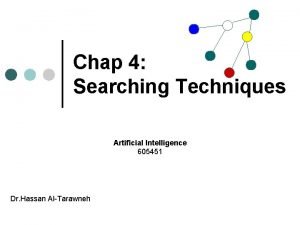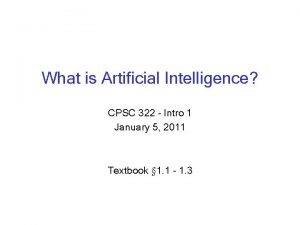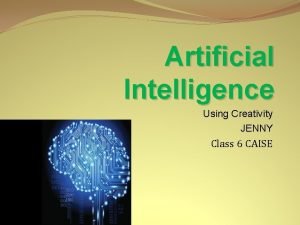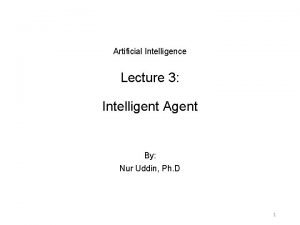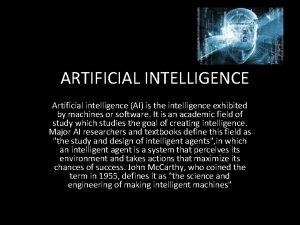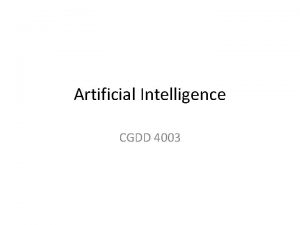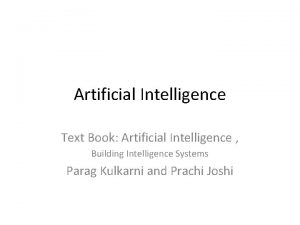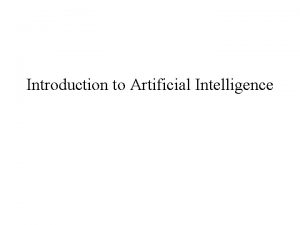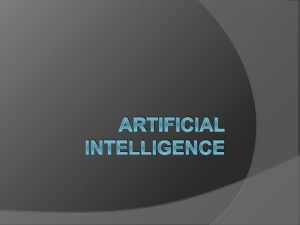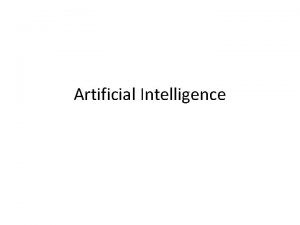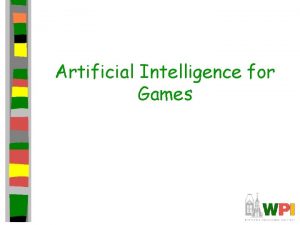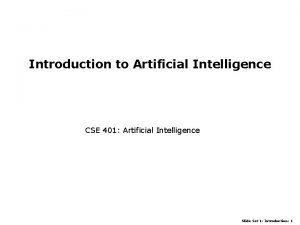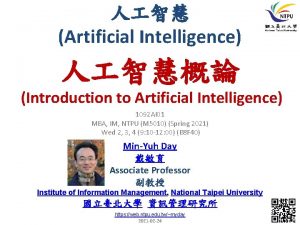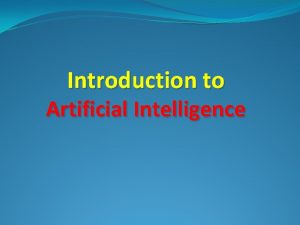Introduction to Artificial Intelligence ARTIFICIAL INTELLIGENCE TECHNIQUES Artificial


























- Slides: 26

Introduction to Artificial Intelligence ARTIFICIAL INTELLIGENCE TECHNIQUES

Artificial Intelligence AI is often divided into two basic ‘camps’ Rule-based systems (RBS) Biological inspired, such as Artificial neural networks (ANN) There also search methods which some people include. Increasingly hybridisation.

In the module Evolutionary algorithm Neural networks Fuzzy Logic Expert Systems and Knowledge Processing Searching Internet and AI

Examples Focus of the applications is the early part of the module is on: Games Robotics Engineering and medicine

Assessment Two assignments mini-projects Applying AI to tasks Early part in Java

Example Areas

Multi-layered perceptron (Taken from Picton 2004) Input layer Output layer Hidden layer

The Ingredients( Taken from: Evo. Net Flying Circus www 2. cs. uh. edu/~ceick/ai/EC 1. ppt ) t reproduction selection mutation recombination t+1

Depth-First Search Taken from Jones (2005)

Breadth-First Search Taken from Jones (2005)

Knowledge Processing Introduce types of reasoning Deterministic Propositional logic Predicate logic Dynamic-non-monotonic Non-deterministic

Using an Expert System Taken from Johnson and Picton (1995)

Internet and ‘AI’ Week A – AI on internet, basic introduction to semantic web, agents. Week B – Microformats Week C – Collective Intelligence and searching 1 Week D – Collective Intelligence and searching 2

Basic structures

Data Structures-Linked List

Data Structures - Stack

Data Structures - Queue

Summary Introduced the module Introduced different types of AI Structures

TASK 1: FINITE-STATE MACHINES

Outcomes By the end of the session you should: Understand what a state diagram is. Understand the principles of a finite state machine Describe a simple system using a state diagram Applications using state diagrams

What is a state?

State diagram (Taken from Picton 2004) yes State 0 wait for the button to be pressed Cup? yes End? Button? State 1 wait for a cup to be placed no

Next-state table (Taken from Picton 2004)

Where are they used? Designing systems Games

Your designing a character for a maze-based game. You must design a state diagram and table for the character.

Further reading and references http: //en. wikipedia. org/wiki/Finite_state_mac hine Picton PD (2004) CSY 3011 Artificial Neural Networks, University College Northampton
 Searching techniques in artificial intelligence
Searching techniques in artificial intelligence Introduction to artificial intelligence and expert systems
Introduction to artificial intelligence and expert systems Cpsc 322: introduction to artificial intelligence
Cpsc 322: introduction to artificial intelligence Cpsc 322 ubc
Cpsc 322 ubc Xoon expert system
Xoon expert system Iterative deepening search prolog
Iterative deepening search prolog Searching for solutions in artificial intelligence
Searching for solutions in artificial intelligence 15-780 graduate artificial intelligence
15-780 graduate artificial intelligence Knowledge manipulation in artificial intelligence
Knowledge manipulation in artificial intelligence What is declarative knowledge in ai
What is declarative knowledge in ai Vandelay art. seinfeld the show about nothing. penguin 1997
Vandelay art. seinfeld the show about nothing. penguin 1997 Artificial intelligence leadership
Artificial intelligence leadership Uas kecerdasan buatan
Uas kecerdasan buatan Math and artificial intelligence
Math and artificial intelligence Performance environment actuators sensors
Performance environment actuators sensors 15-780 graduate artificial intelligence
15-780 graduate artificial intelligence Xkcd deep learning
Xkcd deep learning The number of fuzzy propositions are
The number of fuzzy propositions are Asu cse 571
Asu cse 571 15 780
15 780 Informed and uninformed search
Informed and uninformed search Artificial intelligence for class 6
Artificial intelligence for class 6 Augmented grammar in artificial intelligence
Augmented grammar in artificial intelligence Omniscience in artificial intelligence
Omniscience in artificial intelligence Int 404
Int 404 Solving problems by searching artificial intelligence
Solving problems by searching artificial intelligence Partitioned semantic nets in artificial intelligence
Partitioned semantic nets in artificial intelligence
